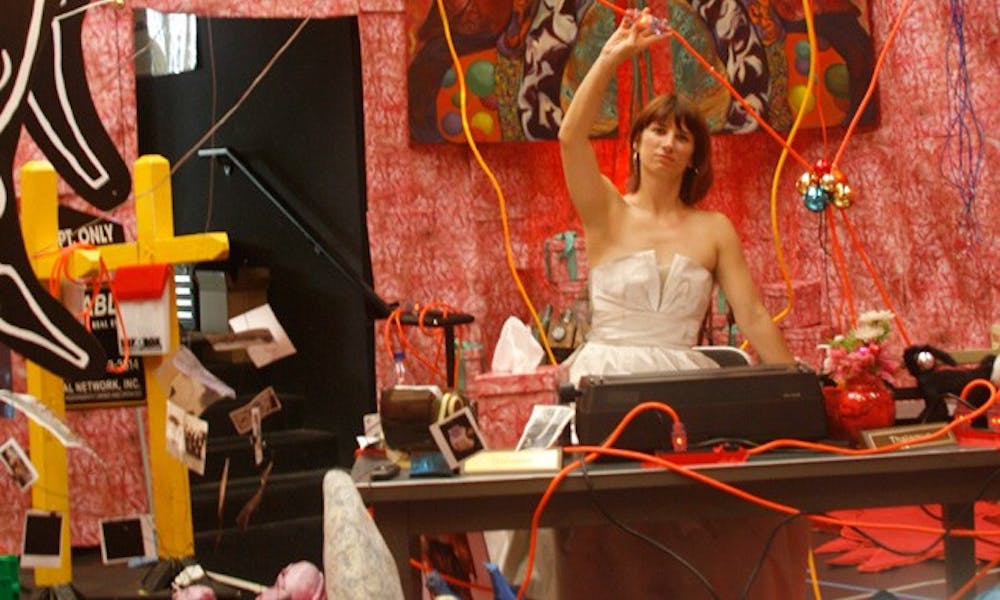Amy Caron is a mad scientist—at least in her most recent work “Waves of Mu,” a two-room immersive experience exploring the complex and controversial nature of mirror neurons. After a break from presenting the show in 2008 and 2009, Caron has begun her second round of touring at Duke. Recess’ Jessie Tang spoke with Caron recently about her initial interest in mirror neurons, new additions to the show and why she isn’t junk science.
How did you go about bringing “Waves of Mu” to Duke?
I had been at Duke in 2003 for the American Dance Festival, and I found out that Duke had a really forward-thinking, cross-departmental program that was happening between the art department and history department and colleges. I [also] found out about their Visiting Artists Grant program and just started sending out some e-mails saying, “Hey, I have this project, if you’d be interested…” And it took a while. It’s not like I got an answer right away. It takes a while to develop a relationship, but eventually Michael Platt and the Center for Cognitive Neuroscience at Duke really jumped at the idea, and Rachel Brady with the Visual Studies Initiative and Computing Science… basically everyone stepped up to make this happen.
What were some challenges holding them back from jumping on board immediately?
It just takes a while to develop a relationship. My work is really hard to describe, even for people who have seen the show. It’s a difficult-to-categorize work. It’s part installation, part visual art. It’s not just a painting, it’s not just a sculpture, it’s an immersive environment with a performance component that happens in another room. It’s about neuroscience and performance art. It’s very entangled. So I just think it’s a difficult thing for people to wrap their minds around and understand. So I think, naturally, organically, it takes a while to form those relationships. It’s a learning curve. Once they understand it or get excited about it, there’s a certain time frame of getting things into alignment and catching the academic wave, you know?
And how did you get interested in mirror neurons?
I read an essay that V.S. Ramachandran wrote in 2001. I was looking to do work for a commissioning program where I would team up with a professional in the field of science. He stuck in my mind, and I somehow was just researching online and found this article, which was pretty controversial at the time and still is. And that got me going—a lot about transferring emotions and attuning with other people and emotional exchange, which is a lot of what I am trying to do as an artist in theater, that interaction with people and stimulating emotional response. So it was kind of enlightening to find out that there were possibly some neurobiological explanations for those exchanges to happen between myself and the audience, or just people that you interact with every day. And I don’t have a science background, but I think that informed outside perspective is a real bonus that I really like learning and using my art as a tool for learning. I’m trying to learn as much as I can while retaining my sense of naivete, which I think is really great for creativity and letting myself have my own interpretations of what I learn.
Now that you’re in the second wave of this project, can you talk about what you’ve learned from the past and how you’re adapting it?
I think what’s nice is that every time you take the work out of the box and put it back on its legs, it’s different. I’ve changed, it’s changed, I get to revisit it and see what it’s like now. The work has some set bones, but it’s always evolving. I’m working with two post-doc students here: Paul Leary is doing an original score and David Paulsen is adding a new component to the neuro-anatomy installation. It’s much like the organ itself—it’s constantly evolving, and constantly developing. I’m working with new actors based here in North Carolina, so they’re going to bring their own flavor to the work.
I’m interested in knowing about how the audience reacts to your work. What have been some of the most baffling or interesting reactions?
Well, we’ve had people laugh, we’ve had people cry, we’ve had the gamut. This work is for a range of audiences. I think some of the best reactions are the plain “I’ve never seen anything like this before, I don’t know what just happened, but I’m really stimulated.” It’s really nice when people from the neuroscience-medical community have said, “You’ve really got it. I know this field, and you got a lot of things right.” That’s encouraging, because it’s important I’m not concerned about getting everything absolutely correct, but I don’t want it to be junk science.
“Waves of Mu” is housed in the Studio and the Schiciano Auditorium of the Fitzpatrick Center. The interdisciplinary artist Caron is in residency at Duke’s Center for Cognitive Neuroscience until Nov. 3, offering eight public performances of her installation. An opening reception for the work also takes place Oct. 18 from 5 to 9 p.m. The performances and opening reception is free and open to the public, but RSVP is required. For more information on how to RSVP, visit dibs.duke.edu.
Get The Chronicle straight to your inbox
Signup for our weekly newsletter. Cancel at any time.

